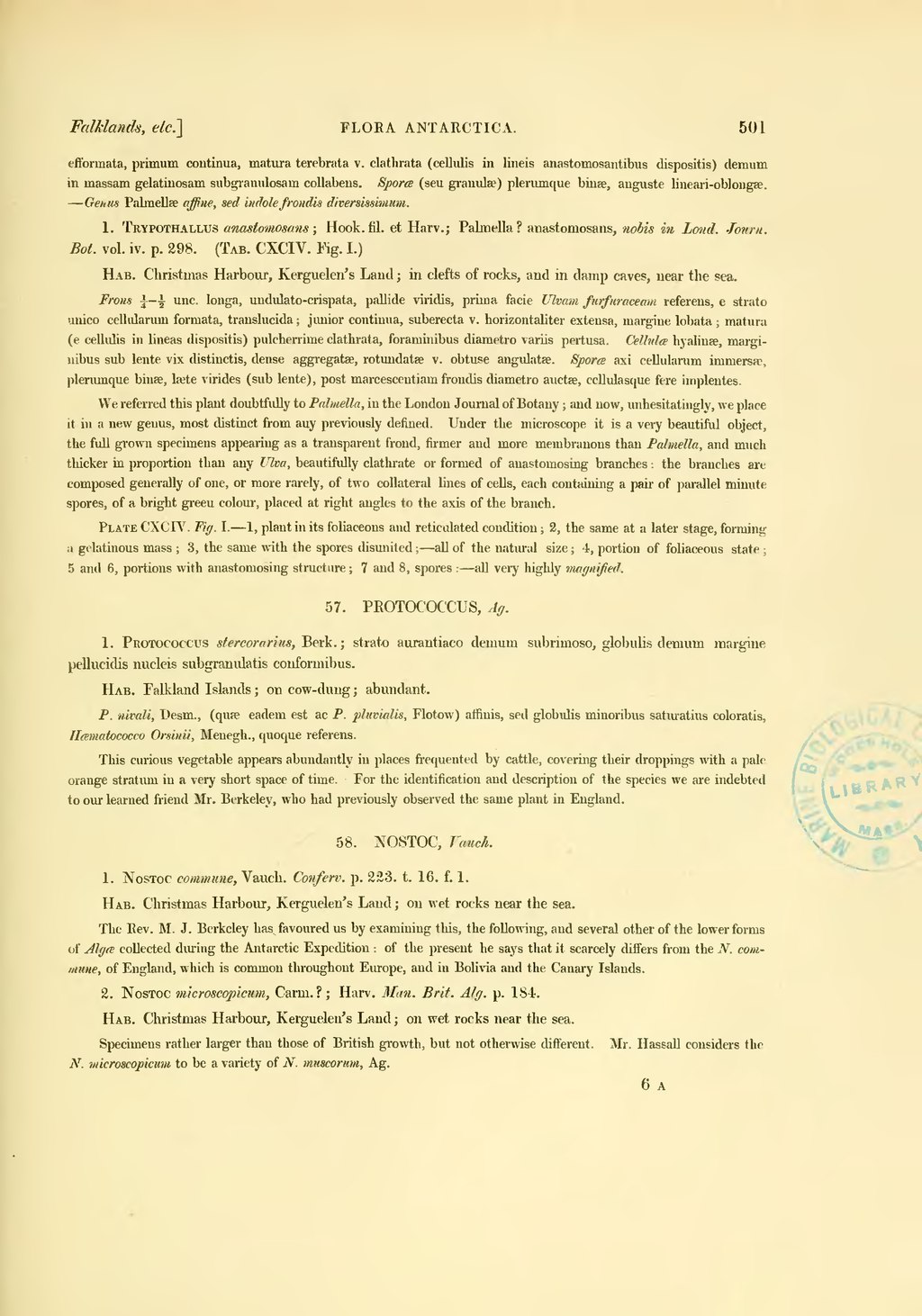efformata, primum continua, matura terebrata v. clathrata (cellulis in lineis anastomosantibus dispositis) demum in massam gelatinosam subgranulosam collabeus. Sporæ (seu granulae) plerumque binæ, anguste lineari-oblongæ. — Genus Palmellæ; affine, sed indole frondis diversissimum.
1. TRYPOTHALLUS anastomosans; Hook. fil. et Harv.; Palmella? anastomosans, nobis in Lond. Jonrn. Bot. vol. iv. p. 298. (Tab. CXCIV. Fig. I.) HAB. Christinas Harbour, Kerguelen's Land; in clefts of rocks, and in damp caves, near the sea.
From ¼-½ unc. longa, undulato-crispata, pallide viridis, prima facie Ulvam furfuraceam referens, e strato unico cellularum formata, translucida; junior continua, suberecta v. horizontaliter extensa, margine lobata; matura (e cellulis in lineas dispositis) pulcherrime clathrata, foraminibus diametro variis pertusa. Cellulæ hyalines, marginibus sub lente vix distinctis, dense aggregatæ, rotundatæ v. obtuse angulatæ. Sporæ axi cellularam immersæ, plerumque binæ, læte virides (sub lente), post marcescentiam frondis diametro auctæ, cellulasque fere implentes.
We referred this plant doubtfully to Palmella, in the London Journal of Botany; and now, unhesitatingly, we place it in a new genus, most distinct from any previously defined. Under the microscope it is a very beautiful object, the full grown specimens appearing as a transparent frond, firmer and more membranous than Palmella, and much thicker in proportion than any Ulva, beautifully clathrate or formed of anastomosing branches: the branches are composed generally of one, or more rarely, of two collateral lines of cells, each containing a pair of parallel minute spores, of a bright green colour, placed at right angles to the axis of the branch.
Plate CXCIV. Fig. I. — 1, plant in its foliaceous and reticulated condition; 2, the same at a later stage, forming a gelatinous mass; 3, the same with the spores disunited; — all of the natural size; 4, portion of foliaceous state; 5 and 6, portions with anastomosing structure; 7 and 8, spores: — all very highly magnified.
57. PROTOCOCCUS, Ag.
1. PROTOCOCCUS stercorarius, Berk.; strato aurantiaco demurn subrimoso, globulis demum margine
pellucidis nucleis subgranulatis conformibus.
HAB. Falkland Islands; on cow-dung; abundant.
P. nivali, Desm., (quæ eadem est ac P. pluvialis, Flotow) affinis, sed globulis minoribus saturatius coloratis, Hæmatococco Orsinii, Menegh., quoque referens.
This curious vegetable appears abundantly in places frequented by cattle, covering their droppings with a pale orange stratum in a very short space of time. Tor the identification and description of the species we are indebted to our learned friend Mr. Berkeley, who had previously observed the same plant in England.
58. NOSTOC, Vauch.
1. NOSTOC commune, Vauch. Conferv. p. 223. t. 16. f. 1.
HAB. Christmas Harbour, Kerguelen's Land; on wet rocks near the sea.
The Rev. M. J. Berkeley has favoured us by examining this, the following, and several other of the lower forms of Algæ collected during the Antarctic Expedition: of the present he says that it scarcely differs from the N. commune, of England, which is common throughout Europe, and in Bolivia and the Canary Islands.
2. NOSTOC microscopicum, Carm. ?; Harv. Man. Brit. Alg. p. 184.
HAB. Christmas Harbour, Kerguelen's Land; on wet rocks near the sea.
Specimens rather larger than those of British growth, but not otherwise different. Mr. Hassall considers the N. microscopicum to be a variety of N. muscorum, Ag.
